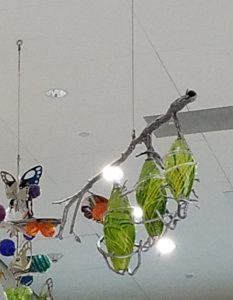Imago Mobiles
Before you leave the Texas Discovery Gardens, be sure to appreciate Imago, the public art installation in the entrance foyer of the Gardens inspired by many aspects of the insect and plant life that abound there. But how can it also inspire us mathematically? There are likely many ways, but one important way is by illuminating the mathematics of balance. For example, take a look at the piece entitled Chrysalis.
 Notice that the branch on which the glass models are hanging is supported only at one point, so it is free to pivot, and yet it hangs perfectly horizontally instead of tilting to the right or left. (You can find a clearer picture on the designers’ website.) In other words, it is in balance. What can you learn from this state of balance?
Notice that the branch on which the glass models are hanging is supported only at one point, so it is free to pivot, and yet it hangs perfectly horizontally instead of tilting to the right or left. (You can find a clearer picture on the designers’ website.) In other words, it is in balance. What can you learn from this state of balance?
You may know that we often use something called a “balance” for weighing things, so here’s a question you can ponder as you gaze at Chrysalis: which is heavier, two model chrysalises or one model chrysalis and two model leaves?
It’s tempting to suppose that since the sculpture is in balance, those weights must be the same. Yet there’s more to it than that, making the situation even more interesting. To explore this, try the following activity: Start by hanging a perforated beam by its center hole (which may be labeled “0”). The beam should roughly balance horizontally, although it may be fairly wobbly. Next, get a supply of mobile ornaments; there should be different types, and they may also be labeled with numbers like 1, 2, 3, 4.
Your goal is to hang an ornament or ornaments on each side of the perforated beam so that it will balance. (Don’t use the center hole, it is just for suspending the beam.) Experiment with different configurations. What kinds of arrangements will balance?
Likely you will discover that hanging two identical ornaments the same distance away from the center of the beam will cause it to balance. And that makes sense: if the two sides are the same, then they should balance each other out.
But do the sides have to be the same in order for the beam to balance? Not necessarily. Try this: hang a “3” ornament in the hole immediately to the left of the center of the beam. Is there anywhere you can hang a “1” ornament to the right of the center to achieve balance?
With some experimentation, you should find that a “1” ornament in the “3” hole just balances a “3” ornament in the “1” hole. And there are other combinations that will balance as well. Try a “2” ornament in the “2” hole against a “1” ornament in the “4” hole. Or put the same ornaments in the “2” and “3” holes on one side and in the “5” hole on the other side. Again, it should balance.
Can you find a rule that will tell you when an arrangement will balance? Again, with some trial and error, you may be able to come up with this rule: take the number on each ornament and multiply it by the number of the hole it is in. Add up those products on each side. If you get the same answer on each side, then the beam should balance. For example, a “2” ornament in the “3” hole and a “3” ornament in the “2” hole on one side should balance a “4” ornament in the “2” hole and a “1” ornament in the “4” hole on the other side, because 2×3 + 3×2 = 12 = 4×2 + 1×4.
Another piece in Imago suggests a more advanced activity:  Suppose instead of being straight, our beam were semicircular. It’s clear that if we hang the beam from its midpoint, it still balances by itself. But where should the other holes be so that the same rule as before will determine when ornaments hung on the semicircular beam will balance?
Suppose instead of being straight, our beam were semicircular. It’s clear that if we hang the beam from its midpoint, it still balances by itself. But where should the other holes be so that the same rule as before will determine when ornaments hung on the semicircular beam will balance?
There are two ways of going about this. The more challenging approach gives participants beams with just the “1” holes already punched, setting the goal of punching additional holes labeled “2”, “3”, etc. so that the rule will still hold. (Note that each participant or group will likely need multiple semicircular beams to work with, as it may take several tries to find the correct hole locations.) Alternatively, each participant or group can be supplied with three different possible hole-punched beams, and they can experiment to find which one works.
In either case, participants should be able to discover that the holes punched at equal intervals in terms of horizontal distance will follow the same balancing rule as the holes on the straight beam did. This may be surprising, because then the holes are not distributed equally around the semicircle. For further mathematical challenge, at the high school level, it’s possible to use a little bit of trigonometry and similar triangles to demonstrate why it is only the horizontal spacing of the holes that matters.

